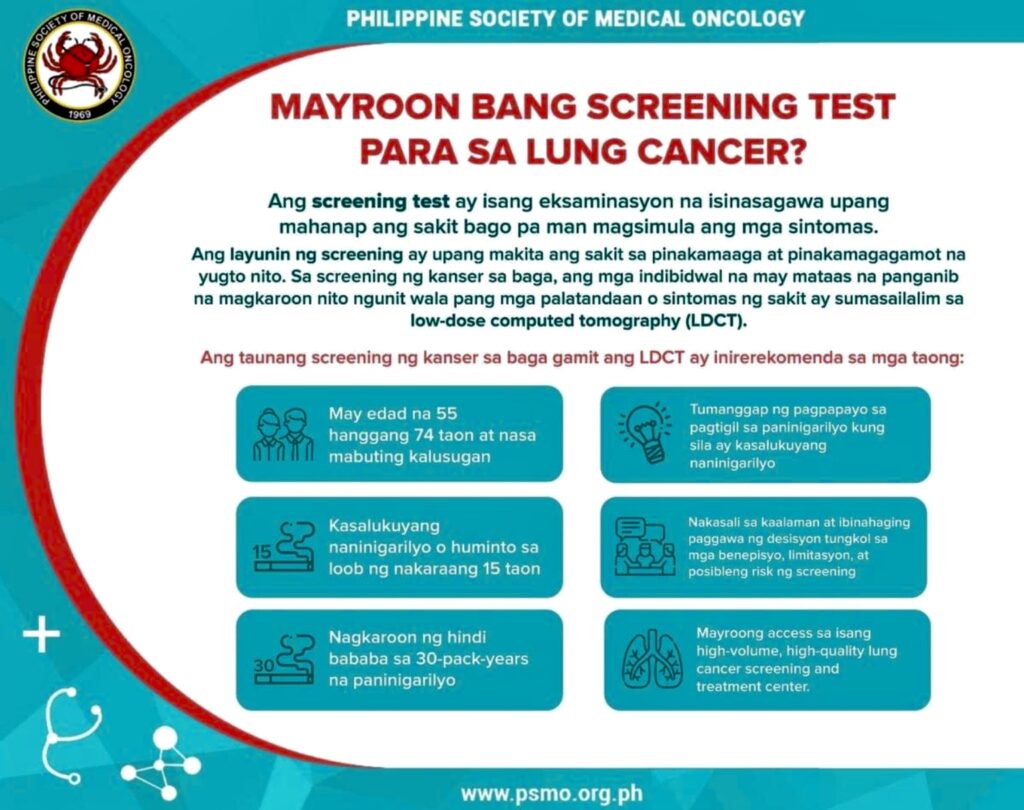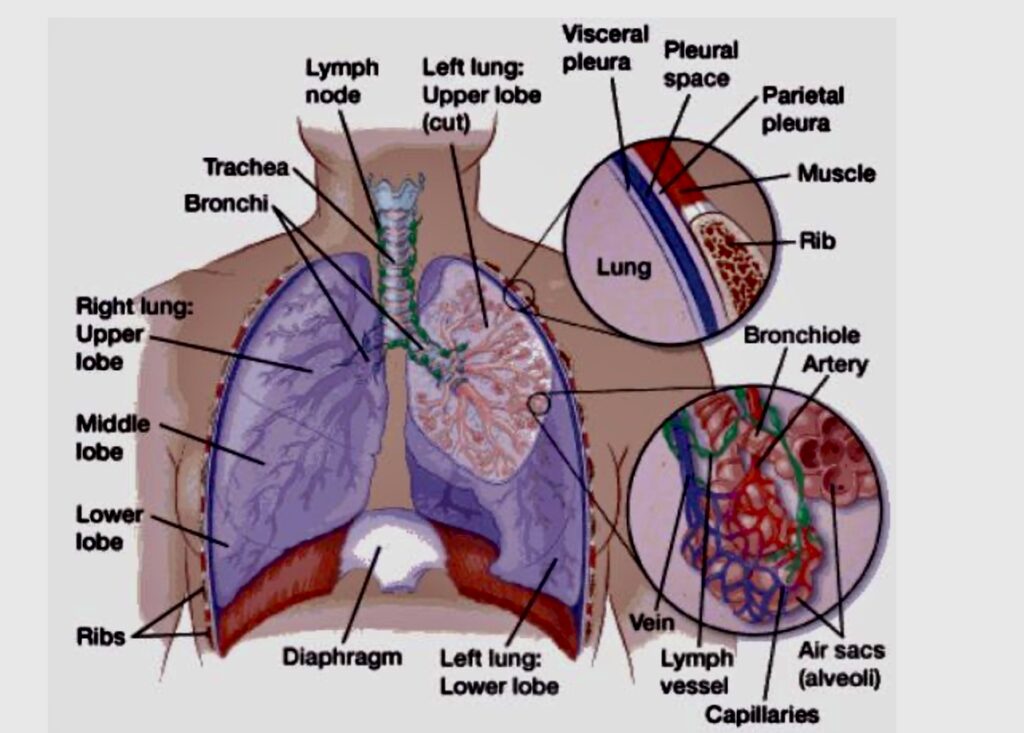Text by Henrylito D. Tacio
Photos: healthline.com, PSMO, and ACS
Many Filipinos thought only ordinary people die of lung cancer. But what they don’t know is that many famous men and women in history died of it. To name a few: Desi Arnaz, Yul Brynner, Joe DiMaggio, George VI, Betty Grable, George Harrison, Bob Marley, Ray Milland, Claude Monet, Jesse Owens, Patricia Neal, Boris Pasternak, and Harry Vardon.
Lung cancer is the most common form of cancer that strikes people. In the Philippines, lung cancer is among the top five cancers leading to death. “More and more Filipinos are dying of lung cancer,” deplores the Philippine Society of Medical Oncology (PSMO).
According to the PSMO, 8,143 men out of 100,000 men are diagnosed with lung cancer, and 6,473 die. Among women, 2,500 are diagnosed with lung cancer out of 100,000, and 2,043 die. “As more people smoke cigarettes, the number of Filipinos with lung cancer is most likely to rise,” it said.
Lung cancer claims 25 lives each day, according to the Cancer Facts and Estimates of the Philippine Cancer Society (PCS). Some 240 Filipinos die each day due to tobacco-related diseases, PCS said.
Culprit: Smoking
Lung cancer is primarily caused by smoking tobacco. Before the advent of cigarette smoking, lung cancer was uncommon. In fact, it was not even recognized as a distinct disease until 1761.
“Cigarette smoking is the cause of about 90 percent of lung cancer cases in men and about 80 percent of cases in women,” points out The Merck Manual of Medical Information. “The greater the quantity and duration of smoking, the greater the risk of developing lung cancer.”
The Geneva-based World Health Organization (WHO) agrees. “Seventy-one percent of lung cancer deaths are caused by tobacco smoking,” the United Nations health agency points out.
Nat King Cole was a lifelong chain smoker. In 1964, the legendary jazz pianist and singer started experiencing weight loss and back pain. When doctors performed an x-ray in December of that year, they discovered a lung tumor and commenced cobalt treatments the following day. In January 1965, doctors removed his left lung. Three weeks later, he died at the age of 45.
Walt Disney smoked unfiltered cigarettes and pipes and was diagnosed with lung cancer in November of 1966. He was also treated with cobalt therapy but died of circulatory collapse caused by lung cancer on December 15, 10 days after turning 65.
Other causes
Even those who don’t smoke are also at risk of getting lung cancer – especially if they are living with someone who smokes. Experts call this second-hand smoke or passive smoking. It is estimated that 17% of cases of lung cancer in non-smokers are caused by second-hand smoke exposure in childhood and adolescence.
“Non-smoking spouses of smokers are 30 percent more likely than spouses of non-smokers to get lung cancer,” explains Drs. Christopher Dolinsky and Christine Hill-Kayser of the University of Pennsylvania Medical School.
Not all cases of lung cancer, however, are due to smoking. A small proportion of lung cancers (about 10 percent in men and about 5 percent in women) are caused by substances encountered or breathed in at work.
Hollywood actor Steve McQueen already stopped smoking when he developed a cough in 1978 that wouldn’t go away. He went to see a doctor and was diagnosed with pleural mesothelioma and lung cancer caused not by smoking but by inhaling asbestos. He was 50 when he died in 1980 after surgery.
“Working with asbestos, radiation, arsenic, chromates, nickel, chloromethyl ethers, mustard gas, and coke-oven emissions has been linked with lung cancer,” the Merck manual informs. “The risk of contracting lung cancer is greater in people who are exposed to these substances and who also smoke cigarettes.”

Lung cancer test (PSMO) 
The Lung
The Merck manual also mentions that about one percent of lung cancer cases are caused by air pollution. Studies of the American Cancer Society also directly link exposure to particulate matter with lung cancer. For example, if the concentration of particles in the air increases by only one percent, the risk of developing lung cancer increases by 14 percent.
Five-time Grammy winner Donna Summer never smoked, and cancer didn’t run in her family, but she died of lung cancer at the age of 63. A report from TMZ said the singer may have gotten lung cancer from inhaling air particles after the September 11 attacks in New York City.
Lung cancer 101
The lungs are two spongy organs found in the chest. They are responsible for delivering oxygen to the bloodstream. When you take a breath in, air moves into the lungs, causing them to expand.
“Most lung cancer originates in the cells of the lungs; however, cancer may also spread (metastasize) to the lung from other parts of the body,” explains Dr. Gary Sy in his column published in a national daily.
Metastatic cancers, according to the Merck manual, spread to the lungs most commonly from the breast, colon, prostate, kidney, thyroid gland, stomach, cervix, rectum, testis, bone, and skin (melanoma).
“There are many different types of growth or tumor that can occur in the lungs,” Dr. Sy says. “It is conventional to divide growths into benign and malignant, and primary and secondary. A benign tumor is one that is unlikely to spread to become life threatening, whereas a malignant tumor grows rapidly, and spreads, thereby threatening life. This happens by direct invasion of surrounding structures or by spreading through the blood or lymphatic system.”
A primary tumor of the lungs is one that has arisen first within the lung tissue; a secondary tumor is one that has arisen elsewhere in the body but has then spread to the lungs.
Signs and symptoms
The symptoms of lung cancer are very non-specific. “This is the reason many patients with lung cancer present at an advanced stage of the disease,” Dr. Sy writes. “One factor hindering or delaying the early diagnosis of lung cancer is that the symptoms, such as cough, are common to other conditions.”
The symptoms include: breathlessness, cough, and chest pain, lethargy, and weight loss. All these symptoms are very common and are present in numerous other conditions. Even coughing up blood (hemoptysis), which is thought by many to be a defining symptom of the condition, is not present in the majority of patients diagnosed with lung cancer.
“Catching the disease early is the key to successful treatment,” Dr. Diana Edralin, country medical director of Roche (Philippines) Inc., told Manila Standard’s, Alena Mae Flores. “Symptoms do not show up until the later stages of lung cancer, but yearly testing can help achieve earlier diagnosis. This is why yearly testing is recommended for smokers or ex-smokers older than 55 years of age, who are the most at-risk for lung cancer.
“It is best to consult your medical oncologist for more information on lung cancer, and learn more about the available and emerging treatment options,” she added.
According to Dr. Edralin, treatment options for patients with lung cancer vary, depending on how it has grown and spread in the body. The main treatment for early-stage lung cancer is surgery to remove the tumor itself or the area where cancer has developed.
Chemotherapy, sometimes coupled with radiation therapy, is another treatment of choice. This is resorted to when cancer has almost always spread to distant parts of the body by the time of diagnosis. In about 25 percent of people, chemotherapy prolongs survival. Chemotherapy involves the use of powerful drugs that directly attack cancer cells and stop it from growing and spreading.
One emerging treatment is called targeted therapy. Also called biological therapy, “it focuses on disrupting the cellular processes that allow cancer cells to divide and propagate that allow cancer cells to divide and propagate so rapidly unlike chemotherapy and radiotherapy, which directly kill cancer cells.”
Dr. Edralin also identified immunotherapy as another emerging treatment. It “works by activating the body’s immune system so that your own immune cells are the ones that attack cancer and stop it from growing and spreading.”
“No matter the treatment, survival rates in lung cancer are best in the early stages, and these drastically decrease as the disease progresses,” Dr. Edralin reminded.
Possible prevention
Like other forms of cancer, lung cancer can also be prevented. “Lung cancer prevention involves proper diet and adequate exercise, avoiding pollution, and most importantly, avoiding smoking and second-hand smoke,” Dr. Edralin said.
But “there is no way to totally prevent lung cancer,” Dr. Edralin pointed out, “and the fight against it is challenging.”

